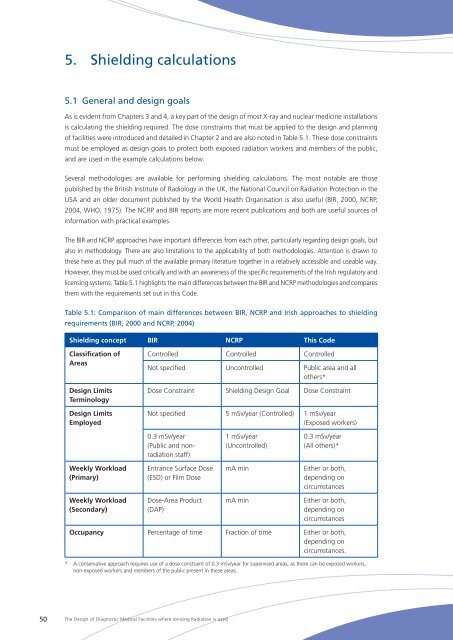The Design of Diagnostic Medical Facilities where ... - ResearchGate
The Design of Diagnostic Medical Facilities where ... - ResearchGate
The Design of Diagnostic Medical Facilities where ... - ResearchGate
Create successful ePaper yourself
Turn your PDF publications into a flip-book with our unique Google optimized e-Paper software.
5. Shielding calculations<br />
5.1 General and design goals<br />
As is evident from Chapters 3 and 4, a key part <strong>of</strong> the design <strong>of</strong> most X‐ray and nuclear medicine installations<br />
is calculating the shielding required. <strong>The</strong> dose constraints that must be applied to the design and planning<br />
<strong>of</strong> facilities were introduced and detailed in Chapter 2 and are also noted in Table 5.1. <strong>The</strong>se dose constraints<br />
must be employed as design goals to protect both exposed radiation workers and members <strong>of</strong> the public,<br />
and are used in the example calculations below.<br />
Several methodologies are available for performing shielding calculations. <strong>The</strong> most notable are those<br />
published by the British Institute <strong>of</strong> Radiology in the UK, the National Council on Radiation Protection in the<br />
USA and an older document published by the World Health Organisation is also useful (BIR, 2000, NCRP,<br />
2004, WHO, 1975). <strong>The</strong> NCRP and BIR reports are more recent publications and both are useful sources <strong>of</strong><br />
information with practical examples.<br />
<strong>The</strong> BIR and NCRP approaches have important differences from each other, particularly regarding design goals, but<br />
also in methodology. <strong>The</strong>re are also limitations to the applicability <strong>of</strong> both methodologies. Attention is drawn to<br />
these here as they pull much <strong>of</strong> the available primary literature together in a relatively accessible and useable way.<br />
However, they must be used critically and with an awareness <strong>of</strong> the specific requirements <strong>of</strong> the Irish regulatory and<br />
licensing systems. Table 5.1 highlights the main differences between the BIR and NCRP methodologies and compares<br />
them with the requirements set out in this Code.<br />
Table 5.1: Comparison <strong>of</strong> main differences between BIR, NCRP and Irish approaches to shielding<br />
requirements (BIR, 2000 and NCRP, 2004)<br />
Shielding concept BIR NCRP This Code<br />
Classification <strong>of</strong><br />
Areas<br />
<strong>Design</strong> Limits<br />
Terminology<br />
<strong>Design</strong> Limits<br />
Employed<br />
Controlled Controlled Controlled<br />
Not specified Uncontrolled Public area and all<br />
others*<br />
Dose Constraint Shielding <strong>Design</strong> Goal Dose Constraint<br />
Not specified 5 mSv/year (Controlled) 1 mSv/year<br />
(Exposed workers)<br />
0.3 mSv/year<br />
(Public and nonradiation<br />
staff)<br />
1 mSv/year<br />
(Uncontrolled)<br />
0.3 mSv/year<br />
(All others)*<br />
Weekly Workload<br />
(Primary)<br />
Entrance Surface Dose<br />
(ESD) or Film Dose<br />
mA min<br />
Either or both,<br />
depending on<br />
circumstances<br />
Weekly Workload<br />
(Secondary)<br />
Dose-Area Product<br />
(DAP)<br />
mA min<br />
Either or both,<br />
depending on<br />
circumstances<br />
Occupancy Percentage <strong>of</strong> time Fraction <strong>of</strong> time Either or both,<br />
depending on<br />
circumstances.<br />
* A conservative approach requires use <strong>of</strong> a dose constraint <strong>of</strong> 0.3 mSv/year for supervised areas, as there can be exposed workers,<br />
non-exposed workers and members <strong>of</strong> the public present in these areas.<br />
50<br />
<strong>The</strong> <strong>Design</strong> <strong>of</strong> <strong>Diagnostic</strong> <strong>Medical</strong> <strong>Facilities</strong> <strong>where</strong> Ionising Radiation is used
















